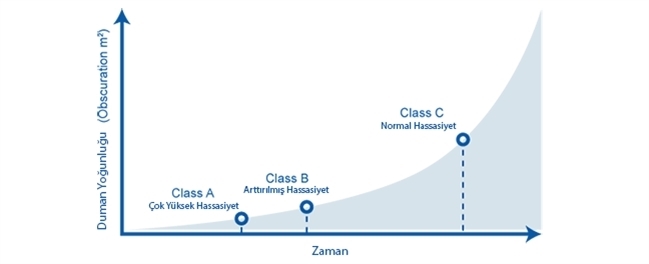
The sensitivity classification of the fire alarm systems has come to prominence since the production of air extractive smoke detectors has started and the concept of “early and sensitive detection” has raised a need for comparison.
Although it is not directly related to air extractive smoke detectors, classification also existed before as a requirement.
The sensitivity classes have been determined in EN54-20 as European Norm, NFPA 72 and NFPA76 as American Norms.
EN54-20 Fire Detection and Fire Alarm Systems – Part 20: Very Sensitive Smoke Detectors with Active Air Extraction
The sensitivity classes described in EN54-20 are as follows:
Class A – Very High Sensitivity: In the areas where very early and sensitive detection is required, where require detection when smoke is mostly sparse in nature, where even low intensity smoke may pose a risk of damage (Data Centers, Clean Rooms or other special areas with early detection expectations)
SecuriSmoke ASD Very Sensitive Air Extractive Smoke Detection Systems »
Class B: (Class B) – Enhanced Sensitivity: In the areas where early detection is required. Especially in the places or cabinets with airflow, in high areas. (Cabinet internal detection, High Production Hall or Storage Halls when necessary...)
Class C – Normal Sensitivity: In the sensitivity of a standard point type smoke detector manufactured in accordance with EN54-7 and in all kinds of normal environments.
The British Standards, which are also accepted as references, are BS 5839-1 and BS 6266.
BS 5839-1 and BS 6266 Fire Detection and Fire Alarm Systems
High Sensitivity – (BS 6266): In the areas where very early and sensitive detection is required, where require detection when smoke is mostly sparse in nature, where even low intensity smoke may pose a risk of damage (Data Centers, Clean Rooms or other special areas with early detection expectations)
Normal Sensitivity – (BS 5839-1): In the sensitivity of a standard point type smoke detector manufactured in accordance with EN54-7 and in all kinds of normal environments.
The standards defining the “detection sensitivities” applicable as the American Norm are NFPA72, NFPA75 and NFPA76.
National Fire Alarm and Signaling Code (NFPA 72)
Standard for the Protection of Information Technology Equipment (NFPA 75)
Standard for the Fire Protection of Telecommunications Facilities (NFPA 76)
Very Early Detection (VEWFD) – Very High Sensitivity: In the areas where very early and sensitive detection is required, where require detection when smoke is mostly sparse in nature, where even low intensity smoke may pose a risk of damage (Data Centers, Clean Rooms or other special areas with early detection expectations)
Early Detection (EWFD) – Enhanced Sensitivity: In the areas where early detection is required. Especially in the places or cabinets with airflow, in high areas. (Cabinet internal detection, High Production Hall or Storage Halls when necessary...)
Standard Detection (SFD) – Standard Sensitivity: In the sensitivity of a standard point type smoke detector manufactured in accordance with EN54-7 and in all kinds of normal environments.